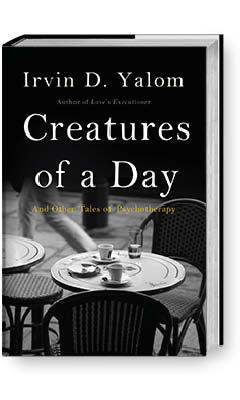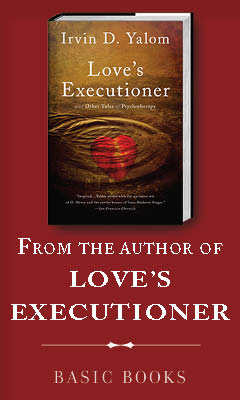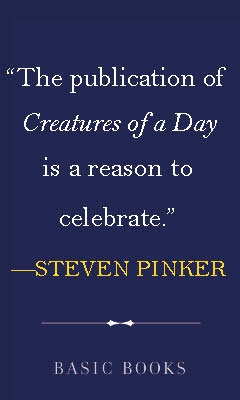Creatures of a Day: And Other Tales of Psychotherapy
by Irvin D. Yalom
There is no preface or foreword to Creatures of a Day, the latest book by Irvin D. Yalom detailing psychoanalysis sessions between Dr. Yalom and 10 of his patients. An introduction isn't really needed; after all, Irvin Yalom is an accomplished, gifted and celebrated existential psychoanalyst who has been treating patients for more than 50 years. A wise and empathic listener and counselor, Yalom has also written extensively, both fiction and nonfiction, about the personal relationship between therapists and patients. His popular 1989 book, Love's Executioner, solidified his literary reputation as a first-class storyteller by offering 10 absorbing, true stories that document what goes on in therapy sessions.
Creatures of a Day serves as something of a companion volume to Love's Executioner, again offering 10 revealing and creatively crafted clinical case studies about real people. This time, however, Yalom focuses less on the entire trajectory of a patient's work and more on incidents and exchanges specific to short-term therapy engagements. What emerges are vignettes where patients examine and question their lives for meaning, value and purpose, which often lead to "aha" moments of epiphany, while also offering a fascinating glimpse into the mind and heart of a mature psychoanalyst at work.
The patients presented are diverse; their problems include anxieties about the struggle to live a meaningful and fulfilling life, coping with the aging process, sustaining losses--including the loss of self--reconciling choices and facing aspects of human isolation. But it is death and its inevitability (in literal and metaphorical incarnations) that emerge as the central unifying theme of these case studies as a whole. This bears out Yalom's fervent belief that it is only when we acknowledge death that human existence can become not just bearable, but also joyful and meaningful.
Two of the stories detail intellectual and philosophical debate between therapist and patient. In "The Crooked Cure," an 84 year-old man, an intellectual obsessed with words, requests a single session with Dr. Yalom in order to address his writer's block. Over the course of a challenging, rather cryptic meeting, Yalom must solve the riddle of why this man has sought him out, why the patient stopped working on his dissertation 60 years earlier and why he wants to address this dilemma now. In the title story, "Creatures of a Day," two of Yalom's male patients--one a bright, clever, commitment-phobe in relationships with two women who both believe he will marry them, and the other a man grossly disenchanted with his career--have their personal states of affairs suddenly shift into focus via the study (and lively discussion) of the work of Marcus Aurelius.
Accomplished and high-functioning individuals with problems rooted so deep as to evade articulation are inherent in "On Being Real," where a well-educated and materially successful 37-year-old business executive, who seems to have it all, is choked by secret self-doubt, insecurity and free-floating guilt. "Don't Fence Me In" deals with a spry, spontaneous, fiercely independent 77-year-old, a former CEO, who staunchly resists the regimented structure of his new living arrangement in a retirement home he feels is confining and prison-like.
The past plays an active role in the present as some patients willingly reveal pivotal and unforgettable moments from their lives. In "Arabesque," Yalom is perplexed and intrigued when a 70-year-old Russian woman shows up at her first session cradling a photograph of herself when she was a prima ballerina at La Scala 40 years before. And in "You Must Give Up the Hope for a Better Past," a restless, 60-year-old physics technician seeks out Yalom for help in overhauling her life and reconnecting with a dream she gave up long ago.
Diagnostic labeling is viewed via its limitations in "Three Cries," a story about a female patient who must come to terms with the death of a lifelong friend who was plagued by psychological troubles. In their work together, Yalom and the woman face the truth about what place this friend actually held in her life, the truth of who he really was and how that truth affected the patient's life--for better or worse.
The intersection of life and death--and eerie coincidences of how closely people are interconnected--underscore "Thank You, Molly," where Yalom attends the funeral of his former assistant, and in the process, meets a patient he once counseled who is now a successful radiologist. Yalom pieces together the surprising connection the radiologist holds to the deceased. A similar theme plays out in "Show Some Class for Your Children," about a nurse who tended to a dying patient, one of Yalom's former therapists-in-training. The nurse seeks out Yalom in order to help heal her own damaged self-image--along with issues of anger, bitterness and rage. In her sessions with Dr. Yalom, she uncovers the impact she made upon his former student.
Throughout, Yalom is wise and well-read, citing passages from Schopenhauer, Nietzsche, Marcus Aurelius, Yeats and Greek mythology. But nowhere is he portrayed as more human and vulnerable than when he counsels the patient in "Get Your Own Damn Fatal Illness: An Homage to Ellie." Here, an introverted, childless, single woman experiences an array of feelings while battling the ravages of cancer and her impending death. In written correspondence she shares with Yalom, the doctor finds himself emotionally distancing himself from the angst of the dying woman. He offers his presence as best he can, but he ultimately admits his own limitations, how his own death anxiety "never really disappears, especially for those... who continue to poke around in their unconscious."
In each case, patients search for their identities--their true authentic selves--while looking for validation that their lives have had meaning and purpose. Through Yalom's gentle wisdom, expertise and leading--coupled with dream recognition and patients taking him through the minutiae of a day in their lives--bonding and healing occurs. The insights Yalom ultimately shares with his patients are often not anything they did not already know. "It's just easier," he states, "to fend off something told to you from the outside than it is something rising from the depths of yourself."
At the time of writing this book, Yalom was approaching his 82nd birthday, and it is clear that his passion for psychoanalysis and helping people in emotional crises and conflict has not waned. He continues to be receptive as he seeks answers to questions of how to help people and serve as a guide for their personal self-exploration and growth. He welcomes each new case and patient dilemma with an analytical mind, personal empathy and an innate curiosity that drives and shapes the two-person narrative dramas that fill this book.
In the end, no two patients or their dilemmas are alike, nor do they reach conclusions and/or self-discovery in the same way or time frame. And while the themes explored may be largely universal, the resolutions certainly are not. Yalom believes that each patient must dive into "a great-souled man's sea of wisdom" in order to emerge on the other side, often in a way that Yalom--and readers--could never predict or anticipate. --Kathleen Gerard








.jpg)
